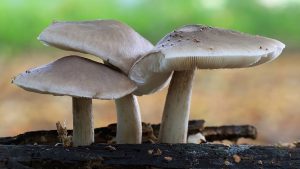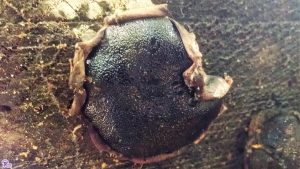#169: Sirex Woodwasp
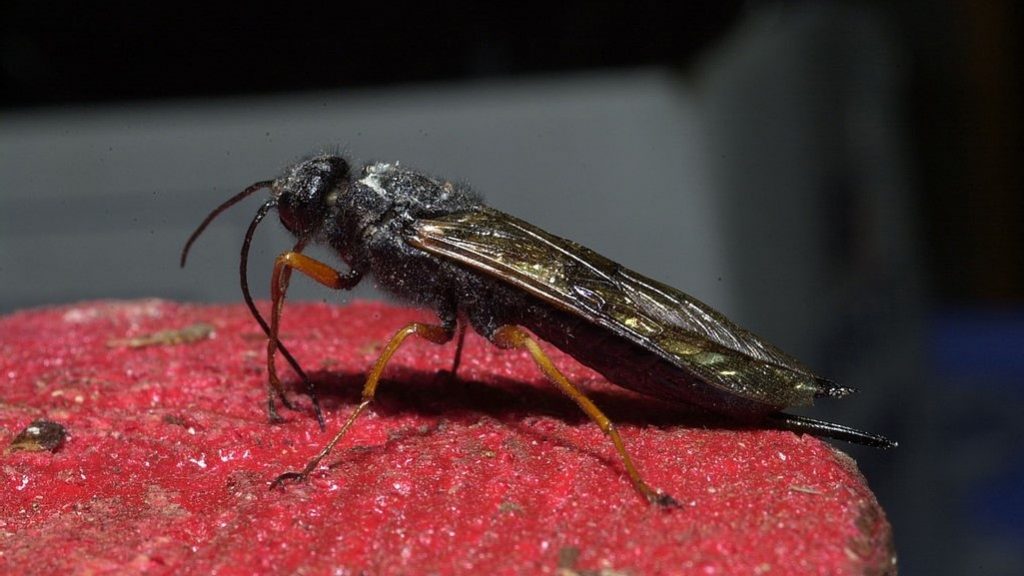
Female Sirex woodwasps (Sirex noctilio) have a dark body, orange legs, and yellow wings. Photo by David R. Lance, USDA APHIS PPQ, United States [CC BY 3.0], via Wikimedia Commons
Woodwasp Description
Sirex woodwasps are actually horntails and not true wasps. Although superficially similar, it is easy to tell wasps and horntails apart: wasps have a very thin waist between their thorax and abdomen, while horntails do not. Horntails have a characteristic spine on the end of their abdomens, but this is not a stinger and cannot be used to harm humans.1
The female Sirex woodwasps are larger than the males and can grow up to 15 – 36 mm long. They have a shiny, dark blue to black body with translucent, yellowish wings and orangish legs.1 Underneath the abdomen, females have two long, backwards-pointing, needle-like projections. The lower one is the ovipositor, which is used to bore into wood and deposit eggs. The upper projection is simply a protective covering for the ovipositor.2 Females also have special organs in their abdomens for storing fungal spores called mycangial sacs.3
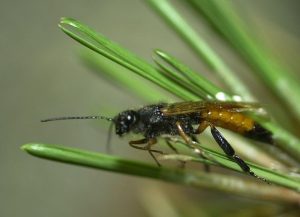
Male Sirex woodwasps (Sirex noctilio) have black bodies with an orange band on their abdomens. Photo by: David R. Lance, USDA APHIS PPQ, United States; derivative work: Toter Alter Mann [CC BY 3.0], via Wikimedia Commons
The larvae of S. noctilio do not have as many features. They are whitish to creamy with a darker head and a prominent, brown spine at the end of the abdomen.1,4
North America has native woodwasps, so only professionals should be trusted to accurately identify Sirex woodwasps and trees infested by S. noctilio.1
Fungus Description
The mutualistic fungus associated with the S. noctilio is Amylostereum areolatum. This fungus causes a white rot in pine trees (see FFF#088 for more on types of rot). Because it is primarily spread by woodwasps, it rarely makes fruiting bodies. Instead, it produces asexual spores called arthrospores that the female woodwasps can easily pick up and carry off.5
A. aerolatum is a crust fungus that can form mushrooms on rare occasions. These mushrooms have a smooth hymenium and are shelf-like but sometimes partially run down their substrate (effused-reflexed to pileate). On top of the mushroom, the pileus is light brown and covered in small, pressed-down hairs. The margin is usually wavy and somewhat irregular. Underneath, the spore-bearing surface is dark brown and smooth.6
Life Cycle & Fungus
The duration of the life cycle of S. noctilio depends on temperature. In warmer areas, the cycle can be completed in as little as ten months. Colder climates, however, increase the required time to as long as two years.2
Adult Sirex woodwasps live a meager 12 days. During this time, the adults do not eat and instead use whatever energy is stored in their bodies. The males generally emerge before the females and gather in large swarms called “leks” near the tops of trees. When a female finds a lek, she flies into it and mates. Afterward, she flies off to lay her eggs while the males stay behind to attract more females.2 The adults are good at flying and can cover great distances in search of suitable mates and/or trees.4
When a female S. noctilio lands on a tree, she drills a small hole into the tree to test how good a host it is. If she finds it satisfactory, she lays one egg in the hole and then moves up and around the tree to drill more holes and lay more eggs. As she lays eggs, she also injects a mucus into the tree. This mucus contains a compound toxic to pine trees. The final hole drilled in the tree receives a load of fungal spores. Females may lay eggs in multiple trees and will lay between 20 and 500 eggs.2
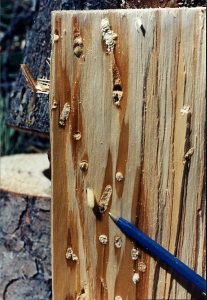
Sirex woodwasp (Sirex noctilio) larva and stains from the fungus Amylostereum areolatum. Photo by Paula Klasmer, Instituto Nacional de Tecnologia Agropecuaria, Argentina [CC BY 3.0], via Wikimedia Commons
After nine or more days, the eggs hatch. The larvae immediately start eating the fungus around them. As they grow, they burrow through the partially-digested wood and leave tunnels filled with sawdust.2 Because the larvae rely on the fungus for food, S. noctilio cannot live without the fungus. The fungus is not as reliant on the Silex woodwasp, but clearly benefits from being carried to new trees.5 After 10 – 11 months, the larvae burrow close to the bark and become pupae. The pupae rest for 16 – 21 days before emerging from the tree as an adult. As the female Sirex woodwasps emerge, they collect fungal spores in preparation for beginning the cycle all over again.2
Symptoms
Silex woodwasps prefer to lay their eggs in trees that are already in decline or recently dead. This is good for foresters, because they only have to check dying trees for signs of woodwasp damage. One of the earliest symptoms of damage is wilting and browning leaves near the top of the tree. If you see this, inspect the tree more closely for other symptoms. Sap often seeps out of the holes the female woodwasp drilled to lay her eggs. Sometimes, this creates small droplets dotted around the bark. Other times, the sap oozes down the bark and paints bold, white, vertical lines on the side of the tree. Another symptom of S. noctilio activity is the presence of exit holes where the adults left the tree.1
Distribution and Impact
The native range of the Sirex woodwasp includes Europe, much of Central and Northern Asia, and parts of North Africa. In these native areas, it causes relatively little damage and is considered a minor pest.7 S. noctilio was introduced to New Zealand in 1900,8 Australia in 1952,9 Uruguay in 1980 (and it has since spread to nearby countries),10 South Africa in 1994,11 and the United States in 2004.3 S. noctilio likely got to many of these areas by hitching a ride inside wooden packaging used to ship goods.2
The impact on forests in introduced areas has so far been minimal. In New Zealand, the greatest impacts were to poorly managed pine plantations. Introductions of biological control agents and better forest management were effective at reducing the Sirex woodwasp in New Zealand and the insect is now considered a minor pest.8 In South Africa and Australia, the greatest threat from S. noctilio is to pine plantations that have not yet been exposed to the insect.9,11 Biological control was unsuccessful at controlling Sirex woodwasps in certain areas of South Africa and South America, which makes it difficult to predict how severe of a threat S. noctilio poses to unexposed areas.9
In North America, S. noctilio was first discovered in the town of Fulton, New York, in 2004.7 It quickly spread to surrounding areas and in 2005 was found in southern Ontario, Canada.12 In the United States, the Sirex woodwasp’s range now includes most of New York, northern Pennsylvania, and scattered areas of Michigan, Connecticut, Vermont, and Ohio.13 As with other parts of the world, Sirex woodwasps are primarily damaging old, unmanaged pine plantations.
The concern in North America is that the insect could spread to the pine plantations of the Pacific Northwest and Southeast. In these areas, damage to forests in that region would likely cost the economy between $2.8 billion and $17 billion.7 S. noctilio certainly has the potential to devastate pine plantations across the U.S. In South American plantations growing North American pines, tree mortality sometimes exceeded 80%.2 The Sirex woodwasp can increase its range by 25 miles every year,7 which is fast but means that – barring any human-mediated movement – it will take a long time to reach the most sensitive areas.

Current distribution of Sirex noctilio. Native range is in green, introduced range is in dark blue, and projected expansion is in light blue. Photo by Roke; derivative work: Toter Alter Mann [CC-BY-SA-3.0 or GFDL], via Wikimedia Commons
Control
Effective control of S. noctilio relies on preventing its spread, effectively managing forests, and using organisms for biological control.
The first line of defense against any invasive species is to prevent its arrival in a country. This is primarily done at ports of entry and requires inspection of all goods that are likely to harbor the pest. Until 2004, this was successful at preventing S. noctilio from becoming established in the U.S.3 Port inspections will still be important to prevent the Sirex woodwasp from independently arriving elsewhere in the country. Unfortunately, as of 2010 the U.S. did not have any regulations in place to control the spread of the insect within the country.14
One of the best control strategies for S. noctilio is proper forest management. The Sirex woodwasp prefers attacking trees that are already stressed. Removing damaged, diseased, or less competitive trees takes away the woodwasp’s preferred habitat. Intentionally thinning healthy trees can help by reducing competition between trees (thus making the remaining trees healthier) and removing suitable S. noctilio mating areas. Any dead trees infested with Sirex woodwasps should be removed and chipped or burned as soon as possible.4
The most successful biological control agent for Sirex woodwasps is the nematode Deladenus siricidicola. This tiny worm specifically attacks S. noctilio and sterilizes the females. D. siricidicola begins its life by eating the Sirex woodwasp’s fungus in the tree. It then gets inside S. noctilio larvae and moves to the reproductive organs. In female woodwasps, the nematode replicates inside the eggs and replaces the embryo. When the female emerges, she mates and then lays sterile, nematode-filled eggs. The nematodes are thus well-positioned to eat more fungus and infect more Sirex woodwasps. D. siricidicola has proven effective at controlling S. noctilio populations and is considered the first choice for biological control of the Sirex woodwasp.4
Parasitoid wasps are other organisms used as biological control of S. noctilio. These wasps lay eggs in or on Sirex woodwasp eggs and/or larvae. The parasitoid’s eggs hatch and eat their hosts, thus reducing the woodwasp population. Ibalia leucospoides and Rhyssa persuasoria are the two most common parasitoid wasps that attack S. noctilio. In North America, both of these species are present and there are also native parasitoid wasps that may help keep Sirex woodwasp populations down.4
Taxonomy
| Sirex Woodwasp | Fungus | |
| Kingdom | Animalia | Fungi |
| Subkingdom | Eumetazoa | |
| Superphylum | Ecdysozoa | |
| Phylum | Arthropoda | Basidiomycota |
| Subphylum | Hexapoda | Agaricomycotina |
| Class | Insecta | Agaricomycetes |
| Order | Hymenoptera | Russulales |
| Superfamily | Siricoidea | |
| Family | Siricidae | Amylostereaceae |
| Genus | Sirex | Amylostereum |
| Species | Sirex noctilio Fabricius3,15 | Amylostereum areolatum (Chaillet ex Fr.) Boidin16 |
See Further:
http://www.arinvasives.org/potential-invaders-of-arkansas/sirex-woodwasp/
http://nyis.info/index.php?action=invasive_detail&id=47
https://www.uaex.edu/publications/PDF/FSA-7071.pdf
http://www2.dnr.cornell.edu/ext/info/pubs/FC%20factsheets/Sirex%20Fact%20Sheet.pdf
http://www.nrs.fs.fed.us/pubs/jrnl/2005/nc_2005_Hoebeke_001.pdf
http://www.fs.fed.us/nrs/tools/afpe/maps/png/SWW.png (current range map)
Citations
- Sirex Woodwasp. Arkansas Invasives Available at: http://www.arinvasives.org/potential-invaders-of-arkansas/sirex-woodwasp/. (Accessed: 9th December 2016)
- John D. Hopkins, Tamara Walkingstick & Jim Lee Wallace. Invasive Woodwasp, Sirex noctilio: A Potential Pest of Pines in Arkansas. (2014).
- E. Richard Hoebeke, Dennis A. Haugen & Robert A. Haack. Sirex noctilio: Discovery of a Palearctic Siricid Woodwasp in New York. Newsletter of the Michigan Entomological Society 50, 24–25 (2005).
- Kevin J. Dodds. Biology and Silvicultural Management of Sirex Woodwasp. (2009).
- Hajek, A. E., Nielsen, C., Kepler, R. M., Long, S. J. & Castrillo, L. Fidelity Among Sirex Woodwasps and Their Fungal Symbionts. Microb Ecol 65, 753–762 (2013).
- Amylostereum areolatum (Chaillet ex Fr.) Boidin, Revue Mycol., Paris 23(3): 345, 1958. Mycobank Available at: http://www.mycobank.org/BioloMICS.aspx?TableKey=14682616000000063&Rec=48121&Fields=All. (Accessed: 9th December 2016)
- Sirex Woodwasp (Sirex noctilio F.). New York Invasive Species Information Available at: http://nyis.info/index.php?action=invasive_detail&id=47. (Accessed: 9th December 2016)
- Bain, J., Sopow, S. L. & Bulman, L. S. in The Sirex Woodwasp and its Fungal Symbiont: (eds. Slippers, B., Groot, P. de & Wingfield, M. J.) 167–173 (Springer Netherlands, 2012). doi:10.1007/978-94-007-1960-6_13
- Sirex woodwasp. Queensland Government Department of Agriculture and Fisheries (2016). Available at: https://www.daf.qld.gov.au/forestry/pests-and-diseases/sirex-woodwasp. (Accessed: 9th December 2016)
- Edson Tadeu Iede, Susete Rocio C. Penteado & Wilson Reis Filho. Sirex Research and Management in South America. (2010).
- What is Sirex noctilio? Institute for Commercial Forestry Research Available at: http://www.icfr.ukzn.ac.za/collaboration/sirex/what-is-sirex-noctilio/. (Accessed: 9th December 2016)
- Sirex Wasp. Tree Canada Available at: https://treecanada.ca/en/resources/tree-killers/insects/sirex-wasp/. (Accessed: 9th December 2016)
- USDA Forest Service, Northern Research Station and Forest Health Protection. Alien Forest Pest Explorer – species map. (2016). Available at: http://www.fs.fed.us/nrs/tools/afpe/maps/png/SWW.png. (Accessed: 9th December 2016)
- Faith Campbell. Sirex Woodwasp. Don’t Move Firewood (2010). Available at: http://www.dontmovefirewood.org/gallery-of-pests/woodwasp.html. (Accessed: 9th December 2016)
- P. Myers et al. ADW: Sirex noctilio: CLASSIFICATION. The Animal Diversity Web (2016). Available at: http://animaldiversity.org/accounts/Sirex_noctilio/classification/#Sirex_noctilio. (Accessed: 9th December 2016)
- Amylostereum areolatum. Mycobank Available at: http://www.mycobank.org/Biolomics.aspx?Table=Mycobank&MycoBankNr_=292521. (Accessed: 9th December 2016)

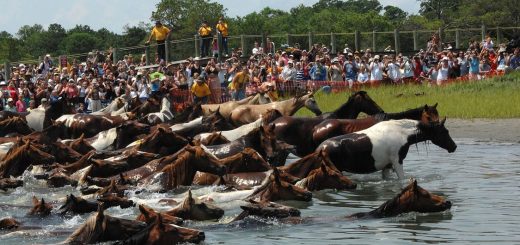
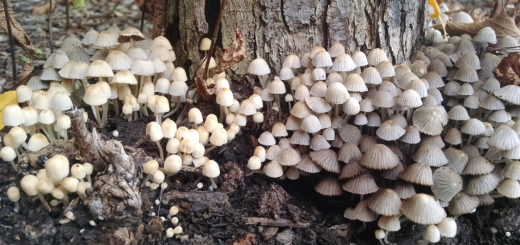






![#011: Characteristics of Kingdom Fungi [Archived]](https://www.fungusfactfriday.com/wp-content/themes/hueman/assets/front/img/thumb-small-empty.png)

